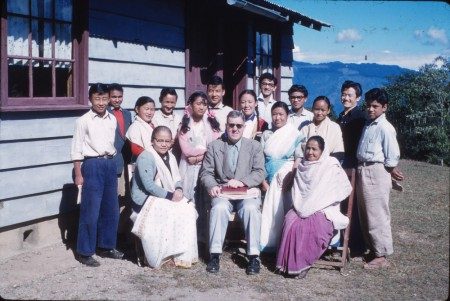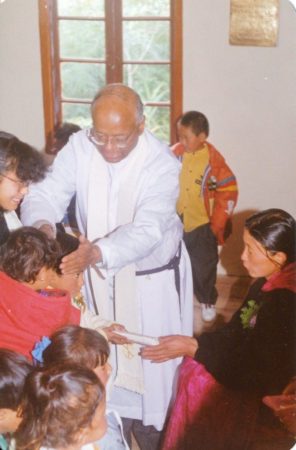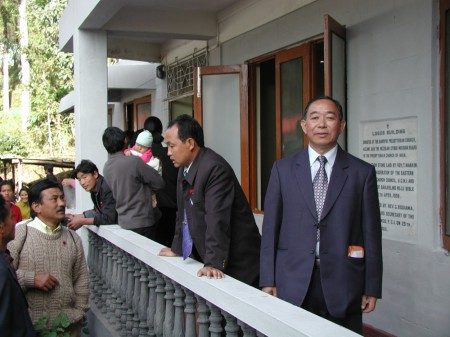Darjeeling Hills Bible School has reached its sixtieth anniversary! We represent the oldest Bible School serving the Nepali-speaking church. No school or institution, I should think, has contributed more to the development of biblically grounded leadership for the Nepali church through the years – and especially in its early days.
God has been faithful along the way!
Permit me to share a few reflections, on this our anniversary year. I was not present myself during those early days, sixty years ago: I was barely a child. Yet I know many who were. They are my heroes.

From hectographs to iPhones…
Ten years ago, I had the privilege of participating in the fiftieth anniversary of Darjeeling Hills Bible School. I consider the event a highlight of my missionary career. As I walked the campus, strolled the surrounding hills, visited with staff, students and other guests, I felt myself standing upon the shoulders of so very many who had gone before – heroes of the faith, visionaries and pioneers, expatriate and national colleagues and friends.
Fran Swenson was one of them – one of my dear friends and personal heroes, now at home with the Lord. I knew Fran for many years. I served with her in our Home Office here in Minneapolis, upon her retirement from service in Nepal.
Fran was impressive to me in so many ways. She was an astute student of the Bible: she knew the Scriptures well. She was an able student of language and culture: she communicated in Nepali, as I understand, almost as well as in her mother tongue. And she was eminently practical. A farm girl, she knew how to milk cows, butcher chickens, pound nails, paint barns, and so on. This impressed me, too.
And Fran knew how to write and duplicate Bible study guides. She taught a few of our early Bible courses, with Pr. Roy and Alma Hagen – who themselves carried the founding vision for Darjeeling Hills Bible School.
Fran was a fan of the latest and greatest practical technology. She employed something called a “hectograph” for duplicating her earliest Bible Study guides. The device consisted of a cake pan, more or less, filled with something like gelatin. The gelatin would receive an image from a specially inked paper. You could duplicate the image on another sheet of paper by pressing it into the gelatin. You could create many copies in this way, apparently, one sheet at a time.
While walking the campus ten years ago, I was surprised to see a hectograph still on a shelf in a storage room: I was told that it was Fran’s. It was stored neatly at about eye-level, as if Fran herself might show up at any moment to make a few copies. I suppose that it is gone by now. Today you might print things wirelessly, I should think, from your iPhone. (Even during Fran’s day, the school used a mimeograph and small offset press in addition to their hectograph.)
The world has changed so very dramatically since Roy and Alma, Fran and the team made lessons on a hectograph.
The campus has grown – from three small cottages, once upon a time, and two classroom spaces, to the expansive campus we see today.

Kanchenjunga still towers above the horizon, as it did sixty years ago. Today, however, internet cafes stand at its base. Tea is grown on the fertile slopes of West Bengal, as it was sixty years ago. Today, however, it is marketed electronically around the world. A steam locomotive still courses through the hills from Darjeeling to the plains below. (Some things do not change quickly.) And most Darjeelingers, I think, still walk wherever they are going. Yet today you can hire a late-model car, too, and travel comfortably from Mirik to Bagdogra or Siliguri in a matter of hours.
Most notably of all, the church has grown. Sixty years ago, we measured the Nepali-language church in the dozens and hundreds. Today we measure it in the millions. There were no Bible Schools serving the church sixty years ago. Today the church has many missions and ministries, projects and institutions, much vision and leadership, energy and dynamic possibility.
We have grown through the years – from the era of hectographs to the world of iPhones, and from a handful of believers to a burgeoning church. The transition presents us with the challenge – and wonderful opportunity – to reinvent ourselves for this new day. We stand on the shoulders of those who have gone before. Yet we strain still forward, toward the horizon of God’s calling and mission in this new day.
From planting to harvest…
I have many other heroes, as well.
I think of dear Roy and Alma Hagen: I have known the Hagen family for very many years. I think of Becky Grimsrud and Millie Hasselquist (now Tengbom), who rented Gurung Cottage in 1951, with sister Ruth Mukhia. They became the nucleus of what became the Bible School. I think of Jonathan and Evie Lindell, Ruthie Overvold, Al and Vallie Berg, Herman and Betty Simrose, Berit and Luther Eriksson, and others. They taught the Word of God. They entered Mirik market, maybe played an accordion, and sold tracts. They opened a little dispensary. They shared the wonderful Gospel story, encouraged inquirers – and then a growing handful of young believers. As young believers appeared, they discipled them.

These were our “planters,” we might say. They sowed a seed of Gospel vision and power. Today we are harvesting the fruit of their labors.
I think of Theodore Manaen in this way – another personal friend and hero. Theodore is a sower and planter of the first order: it is one of his principal spiritual gifts. I have witnessed his gifts first hand as I served with Theodore and his dear wife Arun in our Home Office in Minneapolis. I know Theodore as a brother with wide missional vision – though his physical vision has been failing of late. He is rooted in Scripture and faith, expansive in missional concern, creative in his thinking, and faithful and effective in his relationships. He has a pastoral heart as well. He has been a pastor to me, from time to time.
Theodore envisioned the harvest while Darjeeling Hills Bible School was still planting. Theodore pictured full grain, mature upon the stalk – harvestable, and ready to produce seed of its own for planting again. He helped us to imagine generations of students and ministers, pastors and deacons, Sunday School teachers, counselors and evangelists.
Theodore is a model of prayer, as well. Prayer continues to fuel his vision, and helps him to see beyond our own challenges and uncertainties to the dependable certainties of God’s word and promises. Theodore prays daily for the World Mission Prayer League, I happen to know. He prays for me, personally. I do not doubt that he prays as well for our colleagues and friends at Darjeeling Hills Bible School – where, of course, he has often served as President of our Board of Directors.
We have done much planting through the years; we are harvesting, too. Prayer, we might say, provides the dynamic link between planting and harvest. Prayer factors the promises of God into our thinking and plans, our lives and ministries. We say that “prayer changes things” – and it is certainly true. Prayer also changes us. As we speak to God, he also speaks to us. He reminds us of his grace for our calling, his power for our inadequacies, his faithfulness for our wavering – and his appointed harvest for our obedient planting. “So shall my word be that goes out from my mouth,” God says. “It shall not return to me empty, but it shall accomplish that which I purpose, and succeed in the thing for which I sent it” (Isaiah 55:11).
There is still planting to do. And there remains a further harvest in the Nepali-speaking world. Darjeeling Hills Bible School is still called to participate.
From pioneers to partners…
I have still other heroes in mind.
Sixty years ago, expatriate friends pioneered much of this important ministry. They invested their lives in a vision that they believed in. They became our pioneers.
Pioneering today belongs to another generation, now from local contexts. They invest their lives in the same dynamic global vision. We are partners with these friends in God’s wonderful kingdom: expatriates and national friends, old-hands and younger colleagues, staff and students, generations of alumni and fresh-faced recruits – the entire ministry community of Darjeeling Hills Bible School.
It is important to note that our pioneers and founders were always, in fact, expatriate and national friends partnering together. The threesome that rented Gurung College included Ruth Mukhia, the younger sister of Pr. K.D. Mukhia. Our earliest faculty included Pr. Tshering and Rebecca Rai, at its very core. Our earliest boarding program could not have functioned without Harkamaya Mukhia. Our first advisory board, as I understand, included fourteen Nepali Christians… and two expatriate workers.

I say “our” ministry with intentionality. Our ministries in Mirik have been “partnered” and shared from the very beginning. They have not “belonged” in any unique or exclusive way to the expatriate community – or the national community. Indeed, our entire ministry community, expatriate and national, belongs itself to Another. We partner together in the greater Kingdom of God.
Another of my friends and personal heroes represents this shared, partnering spirit. I think of our current Principal, the Rev. Dr. Kamal Rai.
Once Fran and Ruthie, Theodore and Arun, Roy and Alma, Al and Vallie – and many others – pioneered the work of Darjeeling Hills Bible School. Today the pioneering belongs to a new generation of colleagues and friends – people like Dr. Rai, and the students and staff he has assembled. They represent both past and future of our shared ministry. They stand themselves on the shoulders of others; future generations stand on theirs.
These are people rooted in the Word of God: this is what they offer to the world. These are people redeemed by grace. They are not themselves the “cornerstone” of our edifice: Jesus alone is our Cornerstone. These are people built upon the one and only Savior of the world, redeemed by his grace, equipped by his Spirit, and enlisted for service in his wonderful Kingdom.
Our Lord advises us to build with people like these, as they are built upon the Savior (Ephesians 2:20).
In common service to the King…
It is the Savior himself, the King of Kings, who makes this partnership possible.
For we do not serve, in the end, a denomination, or nationality, or language group, or favorite institution – not even the illustrious Darjeeling Hills Bible School. We serve the King. We are enlisted in his broad and wonderful Kingdom. It is he who draws us ever to the horizon, and then beyond. He is the one who has called into being Darjeeling Hills Bible School, many years ago. He is the one who leads onward.
Great article, Chuck! But the first photo has two names inverted. The second from the left is Betty Hanson Simrose. The other labeled as her must be Helen Hjelmervik!
Thank you, Becky! Chuck has been assisting me in putting an order to the names associated with that photo. We were getting close. Thank you for the additional insights.
Such a great photo! So many stories wrapped up in those lives, I’m sure. And, I just noticed the sign on the wall … GOD IS FAITHFUL. Amen!
Thank you for the article!!
Thank you for great memory
I have found this site in a search for Alma Hagen. She and her late husband Roy, were very kind to our family when we were in HK, and I would very much like to reconnect with Alma. Today I , yet again, used the Dahl recipe she gave me in 1979!
We would like to serve at the Bible school. It is heart touching to see how God has workedthrough the school